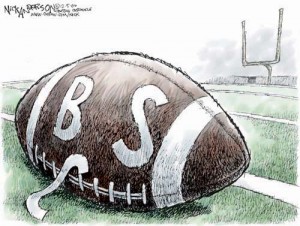BcS
Part 2-What The Hell Is It And How Does It “Work”
What is the BCS? The Bowl Championship Series (BCS) is a system that was created in 1998 to ensure that the No. 1 and No. 2 teams in college football would always play each other for the national championship. It was also created to stop college football from having seasons with multiple national champions. The funny thing is, it hasn’t even done that. Please see USC/LSU 2003.
Hmmm…that sounds pretty awesome. Finally #1 and #2 will actually play for the title. It’s about time, right? Okay, how does the BCS ensure that the two best teams play each other?
It’s a three part system:
1. 1/3 of the ranking is made up from the Harris Poll. The Harris poll replaced the AP poll after the AP poll thought it was ridiculous to pick teams using polls to play a title game. The first poll will be released October 10, then weekly through December 5. A team’s score in the Harris poll will be divided by 2,825, which is the maximum number of points any team can receive if all 113 voting members rank the same team as Number 1. Example: 2,825 / 2,825 = 1.0. If a team receives a total of 113 voting points, an average of 25th place, their BCS quotient of this component would be .04. (1.0 / 25 = 0.04).
Sounds pretty legit, right. I mean, they use math and everything. The only problem is many of the voters in the Harris poll are former players or administrators, they have families and businesses and other interests. In other words, they don’t have time to watch 25 teams let alone 60 or so a week. How the hell can they possibly know who is the best team out there? And don’t forget…those former players and admins probably don’t have any bias…right? Here is an actual exchange between a Harris Poll voter and a columnist from the Oklahoman in November 2008:
Writer: Who is at the top of your poll?
Voter: Oh, I don’t know. Doesn’t really matter.
Writer: Really?
Voter: I think Alabama and Penn State will probably play for the national championship.
Writer: You do?
Voter: They’re the only undefeated teams, aren’t they?
Writer: Uh, actually, Penn State had a loss.
Voter: Oh, well…Those Big Ten teams have a lot of votes.
Keep in mind, this idiot is helping to determine who the best team in college football is, and I’m sure he isn’t alone.
2. 1/3 of the ranking is made up from the Coaches poll. A team’s score in the USA Today poll will be divided by 1,475, which is the maximum number of points any team can receive if all 59 voting members rank the same team as Number 1. Example: 1,475 / 1,475 = 1.0. If a team receives a total of 59 voting points, an average of 25th place, their BCS quotient of this component would be .04. (1.0 / 25 = 0.04).
Cool! More numbers and formulas and stuff. Must be totally legit! There is no way coaches would ever show any bias with these rankings, right? With all the time and effort that goes into preparing their own teams for battle, how on earth do they have time to watch all the other games going on during their own games and decide who the beset team is?
“I don’t know why we vote,” South Carolina coach Steve Spurrier said. “I guess we vote because college football is still without a playoff system. I really believe most coaches do not know a whole lot about the other teams.” Again, this makes up for 33.3% of the rankings.
3. 1/3 of the rankings comes from computer rankings, 6 to be accurate.
The computer rankings percentage is calculated by dropping the highest and lowest ranking for each team and then dividing the remaining total by 100, the maximum possible points. (Example: the 6 rankers have Team A ranked 2, 3, 3, 3, 3, and 4. Take away the 2 and 4 which leaves an average of 3rd place. The BCS quotient of this component would be 0.92. (23 / 25 = 0.92).
Peter Wolfe
Wes Colley
Sagarin
Seattle Times
Richard Billingsley
Kenneth Massey
These guys make up the 6 polls. Some of them actually post more accurate versions of their polls online.
Okay, so there should be no bias here, I mean they are computers. It’s not like Johnny 5 is calling the shots or even that stupid ass robot from Space Camp. So what could be wrong with the computer rankings?
Well  for one, none of the models use margin of victory. A 73-0 win is the same as a 7-3 win. So it’s a good thing political correctness has leached into a friggin computer, isn’t it? I mean, why input important data like how dominant a team is. Only 1 of the 6 computer rankings are made public and that means the other 5 open to corruption. Kenneth Massey said “it would take a lot of will power to refuse that, to be sure,” when asked if he would accept a million dollar bribe to doctor his standings. And this is the guy heading up 1/6th of the CPU rankings?
So we are also using a watered down and possibly corrupt computer ranking system that has been changed three times since it started.
There isn’t a single aspect of the BCS makes me believe that they get it right every year. Last year 5 teams finished the regular season undefeated. Bias coaches, biased and incompetent former players and other dumb humans  and flawed computer systems picked the two teams that competed for the championship of the sport we all love.
So how does it work? It’s pretty simple…It doesn’t.


Johnny, I love what you’re doing here, seeing as how I’m about as anti-BCS as a person can get, but I do think you owe a little credit to the Death to the BCS authors, don’t you?
With that out of the way, this is a pretty good summary of what’s wrong with the BCS formula. I would add that the constant tweaking since the beginning of the system shows that there is no realistic way to determine the two “best” teams via mathematics. There are many reasons for this, but the main one is the concept of intangibles, which by definition can not be quantified or calculated.
This is why a playoff with a reasonably-sized field of teams is needed. I personally think March Madness is a tad bloated (but still pretty awesome) and that 16 is the best number for football (at least in the current 120 team reality). First of all, 16 promotes fairness, allowing an automatic spot for each of the 11 conference champions. Granted, Troy is probably never going to win a playoff against the likes of Ohio State, Texas and USC. But does that mean they don’t deserve a chance to try – and more importantly, a piece of the truckload of cash a playoff would bring?
16 also allows for at-large berths, important in recognizing that great teams sometimes suffer fluke losses. When the BCS argument comes down to 5 one-loss teams, it gets really hard to convince anyone that you’re picking the right two. With only 5 at-large spots, the competition to score one would still be pretty heated.
I hear what you are saying, but margin of victory seems to be one of the least useful statistics one could use to rank teams, especially if you are moving beyond comparing just 2 schools based solely on how badly they beat one other team. How do you use margin of victory to compare 2 schools who do not play the same schools? Blowing out Lollipop State (0-10) by 70 says nothing more important than beating Ohio State (10-1) by 3.
Every time a statistic is used that is not multi-tiered wins/losses based making the assumption that all FBS schools are created equal is the definition of bias.
Time for a Playoff has come, we just have to figure out how to create more money for the schools and TV networks for it to happen.
Oh, and somehow convince the NCAA that they need to come to grips with reality and stop assuming that most D1 Football Student-Athletes give a crap about being students.
@Jason-You are ABSOLUTELY right. Though I’ve been wanting to do this for a long time, Death to the BCS has definitely been the catalyst for this.
An overwhelming majority of fans hate the BCS and hate the fact that there isn’t a playoff system. This book will certainly fuel the fire and hopefully educate a lot of people about why the BCS is bad and why a playoff is good.
I’ll also be doing a summary of Wetzel’s idea for a playoff along with some thoughts of my own.
@Brigham-The book mentioned above has a before and after of what happens when that data point is pulled out. Let’s just say with out of there one team made it into a title game that shouldn’t have. It’s pretty shocking.
Another problem I have with the computer rankings is they are based on stats and as we all know, stats are like sluts, you can do anything with them…just like the BCS has done changing the formula time and time again.
Another thing that is not taken into account in strength of schedule is home field advantage. Think of this: Last year we all witnessed Purdue harbor. This game was played in front of 62500 people. In your major conferences, chances are you will be playing in front of large riled up crowds with no less than 50000 fans. This can be a signifigant advantage for the home team. I just watched Boise state play last night in what looked like a gymnasium!!! Idaho’s Kibbe Dome seats a whopping sixteen grand. The average opponent’s max capacity this year for boise’s scheduled away games is about 25 grand. I guess what I am saying is it’s one thing to play in a conference where you are the only good team, it’s another when you go on the road and only have to play against the other team’s parents and girlfriends!!!! I hope oregon and auburn both lose on the road in their conf. This will give us TCU and Boise in the title game that will have BCS folks freaking out!!!! maybe something will change!!